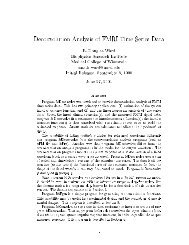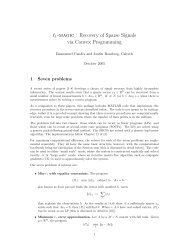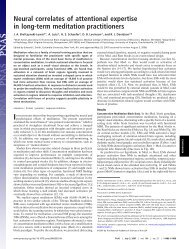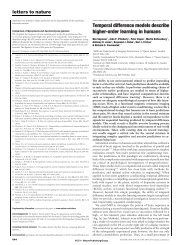DUCHENNE SMILE 351views, negative emotional reactions to what they interpreted asteasing of the puppy or the confinement of apes in a zoo. <strong>The</strong>EEG data during other smiles certainly support the possibilitythat at least when they occur when watching the positive films,the other smiles are actually a sign of negative affect. Other researchin which the subjective report of emotion is obtainedimmediately after the appearance of the smile, <strong>and</strong> in whichmore samples of different kinds of other smiles are examinedin relation to the measures of cerebral asymmetry, is needed tofurther explore these possibilities.<strong>The</strong> amount of <strong>Duchenne</strong> smiling also was related to differencesamong positive affect experiences, not just the grosset distinctionbetween positive <strong>and</strong> negative affect. Making such asubtle distinction as to which of two positive experiences is themost positive was not possible based on other smiling.It is worth noting that the subjects were alone when they werewatching the films <strong>and</strong> did not know they were being videotapedor observed. As predicted, facial expressions did occur inthis solitary situation. <strong>The</strong>se expressions were not r<strong>and</strong>om, butinstead were related to the type of film viewed, the subjectivereport, <strong>and</strong> physiology. In this respect these data are consistentwith earlier reports that facial expressions of emotion do occurwhen people are alone (Ekman, 1972; Ekman et al., 1980) <strong>and</strong>contradict the theoretical proposals of those who view expressionssolely as social signals. This is not to suggest that our findingsmean that emotional experience or expression has nothingto do with social interaction. It is only that emotions can occurwhen one is alone as well as when one is with others. Obviously,it is the actions ofotbers that most often bring forth an emotion.More specifically, the presence of others who are also experiencingenjoyment typically will increase enjoyment expressions,even when the source of the enjoyment is not a conversationbut an activity such as watching a film.<strong>The</strong> cerebral asymmetry findings indicate that, as predicted,the two types of smiling differ in the pattern of regional brainactivity with which each is associated. <strong>Duchenne</strong> smiles are associatedwith more left-sided anterior temporal <strong>and</strong> parietal activationcompared with other smiles. Although the left-sided anteriortemporal activation was predicted to accompany positiveaffect, it is not clear what activation of the left parietal regionmight reflect in this study. Other EEG asymmetry studies havefound that verbal cognitive activity reliably increases left parietalactivation (e.g., Davidson et al., in press; Ehrlichman &Wiener, 1979). It is therefore possible that in the present context,the <strong>Duchenne</strong> smiles were accompanied by more verbalthinking compared with other smiles. In future studies it wouldbe useful to assess cognitive activity in addition to experiencedemotion, in order to evaluate this suggestion. <strong>The</strong> lack of anydifference in central EEG activity between the <strong>Duchenne</strong> smiles<strong>and</strong> other smiles suggests that the differences in asymmetry betweenthese smile types that were seen in other regions are nota function of differences in motor asymmetry, because centralEEG asymmetries are very sensitive to motor differences betweenthe two sides of the body (e.g., Coles, Gratton, Bashore,Eriksen, & Donchin, 1985; Kutas & Donchin, 1974).Other smiles show a pattern of activation asymmetry similarto what has been reported for withdrawal-related negative affect(see Davidson et al., 1990). In fact, when we examined othersmiles, we found that the majority did contain facial actionsdenoting negative emotion.Contrary to prediction, <strong>Duchenne</strong> smiles did not differ signifieantlyfrom baseline. This is the same pattern as was foundfor happy facial expressions in the accompanying article (Davidsonet al., 1990). Davidson (1984) has reasoned that positiveemotion is associated with left-sided anterior activation relativeto a baseline only when the positive emotion is accompanied byapproach behavior. As we noted in the accompanying article(Davidson et al., 1990), not all forms of positive affect includean approach component. <strong>The</strong> <strong>Duchenne</strong> smile marks a numberof rather different positive affective states, not all of which involveapproach. For example, contentment may not involve eitherapproach or withdrawal. Amusement may involve approach(when it develops in response to a comedian unfoldinga funny joke), or it may not, as we believe happened when subjectswere amused watching our films of a dog, monkeys, <strong>and</strong>gorillas playing. <strong>The</strong> reason for our failure to find a differencein anterior asymmetry between <strong>Duchenne</strong> smiles <strong>and</strong> baselinemay be that in this context, the <strong>Duchenne</strong> smile marked a formof positive affect with little or no approach component. In studieswhere unambiguous indices of approach behavior accompaniedpositive affect (i.e., an infant reaching toward its mother<strong>and</strong> smiling), significant left anterior activation was observedrelative to a preceding comparison condition (Fox & Davidson,1987, 1988). In the accompanying article, we offer several suggestionsfor how to measure "approach" happiness so that thisform of positive affect can be compared with other nonapproachforms of positive affect, such as the type of amusementelicited in this study. We also make clear that our idea that theamusement aroused in our experiment did not involve approachis admittedly ad hoc. We offer other alternative interpretationsof our data, <strong>and</strong> explain why we believe they are lesstenable.<strong>The</strong> analysis of beta power activity revealed little. As expected,the majority of the significant effects were in the alphab<strong>and</strong>. <strong>The</strong> only finding to reach significance for beta power wasthe difference in asymmetry between baseline <strong>and</strong> other smilesin the parietal region. <strong>The</strong> direction of this difference was identicalto that found in alpha power--more power suppression inthe right hemisphere during other smiles compared with baseline.<strong>The</strong> fact that alpha <strong>and</strong> beta power change in the samedirection is consistent with other findings from our laboratoryon EEG asymmetries in these b<strong>and</strong>s in response to wellmatchedcognitive tasks (Davidson et al., in press).Quite apart from what we have learned about the <strong>Duchenne</strong>smile as an index of enjoyment, our study also showed the feasibility<strong>and</strong> value of obtaining multiple measures in the studyof emotion. Measures of facial expression were related to selfreport<strong>and</strong> to different patterns of concomitant brain activity.In another report (Davidson et al., 1990) we extend our focusbeyond smiles, considering negative facial expressions as wellas positive ones, <strong>and</strong> again show the value of combining expressive<strong>and</strong> physiological measures in the study of emotion.ReferencesAndrew, R. J. (1963). Evolution of facial expression. Science, 141,1034-1041.
352 P. EKMAN, R. DAV1DSON, AND W. FRIESENBirdwhistell, R. L. (1963). <strong>The</strong> kinesic level in the investigation of emotions.In P. H. Knapp (Ed.), <strong>Expression</strong> of the emotions in man (pp.123-139). New York: International Universities Press.Birdwhistell, R. L. (1970). Kinesics <strong>and</strong> context. Philadelphia: Universityof Pennsylvania Press.Blurton Jones, N. G. (1972). Non-verbal communication in children.In R. A. Hinde (Ed.), Nonverbalcommunication (pp. 271-296). Cambridge:Cambridge University Press.Brannigan, C. R., & Humphries, D. A. (1972). Human nonverbal bebavior,a means of communication. In N. G. Blurton Jones (Ed.),Ethological studies of child behavior (pp. 37--64). Cambridge: CambridgeUniversity Press.Bruner, J. S., & Tagiuri, R. (1954). <strong>The</strong> perception of people. In G.Lindzey (Ed.), H<strong>and</strong>book of social psychology (Vol. 2, pp. 634--654).Reading, MA: Addison-Wesley.Clark, L. A., & Watson, D. (1988). Mood <strong>and</strong> the mundane: Relationsbetween daily life events <strong>and</strong> self-reported mood. Journal of Personality<strong>and</strong> Social Psycholog~, 54, 296-308.Coles, M. G. H., Gratton, G., Bashore, T. R., Eriksen, C. W., & Donchin,E, (1985). A psychophysiological investigation of the continuousflow model of human information processing. Journal of ExperimentalPsychology: Human Perception <strong>and</strong> Production, 11, 529-553.Darwin, C. (1955). <strong>The</strong> expression of the emotions in man <strong>and</strong> animals.New York: Philosophical Library. (Original work published 1872)Davidson, R. J. (1984). Affect, cognition <strong>and</strong> hemispheric specialization.In C. E. Izard, J. KaZan~ & R. Zajonc (Eds.), Emotion, cognition<strong>and</strong> behavior (pp. 320-365). New York: Cambridge University Press.Davidson, R. J. (1987). Cerebral asymmetry <strong>and</strong> the nature of emotion:Implications for the study of individual differences <strong>and</strong> psychopathology.In R. Takahashi, P. Flor-Henry, J. Gruzelier, & S. Niwa (Eds.),Cerebral dynamics, laterality <strong>and</strong> psychopathology (pp. 71-83). NewYork: Elsevier.Davidson, R. J., Chapman, J. P., Chapman, L. P., & Henriques, J. B. (inpress). Asymmetrical brain electrical activity discriminates betweenpsychometrically matched verbal <strong>and</strong> spatial cognitive tasks. Psychophysiology.Davidson, R. J., Ekman, P., Saron, C., Senulis, J., & Friesen, W. V.(1990). Approach-withdrawal <strong>and</strong> cerebral asymmetry: <strong>Emotional</strong>expression <strong>and</strong> brain physiology I. Journal of Personality <strong>and</strong> SocialPsychology, 58, 330-341.Diener, E., & Emmons, R. A. (1984). <strong>The</strong> independence of positive <strong>and</strong>negative affect. Journal of Personality <strong>and</strong> Social Psychology, 47,1105-1117.<strong>Duchenne</strong>, B. (in press). <strong>The</strong> mechanism of human facial expression oran electro-physiological analysis of the expression of the emotions (A.Cuthbertson, Trans.). New York: Cambridge University Press. (Originalwork published 1862)Ehrlichman, H., & Wiener, M. S. (1979). Consistency of task-relatedEEG asymmetries. Psychophysiology, 16, 247-252.Ekman, P. (1972). Universals <strong>and</strong> cultural differences in facial expressionsof emotion. In J. Cole (Ed.), Nebraska Symposium on Motivation,1971 (pp. 207-283). Lincoln: University of Nebraska Press.Ekman, P. (1977). Biological <strong>and</strong> cultural contributions to body <strong>and</strong>facial movement. In J. Blacking (Ed.), <strong>The</strong> anthropology of the body(pp. 34-84). London: Academic Press.Ekman, P. (1985). Telling lies. New York: W. W. Norton.Ekman, P. (1989). <strong>The</strong> argument <strong>and</strong> evidence about universals in facialexpressions of emotion. In H. Wagner & A. Manstead (Eds.), H<strong>and</strong>bookof psychophysiology: <strong>The</strong> biological psychology of emotions <strong>and</strong>socialprocesses (pp. 143-164). London: John Wiley Ltd.Ekman, P., & Friesen, W. V. (1969). <strong>The</strong> repertoire of nonverbal behavior:Categories, origins, usa~_.de, <strong>and</strong> coding. Semiotica, 1, 49-98.Ekman, E, & Friesen, W. V. (1974). Deteeting deeeption from body orface. Journal of Personality <strong>and</strong> Social Psycholog£, 29, 288-298.Ekman, P., & Friesen, W. V. (1975). Unmasking the face: A guide torecognizing emotions from facial clues. Engl~a3od Cliffs, NJ: Prentice-Hall.Ekman, P., & Friesen, W. V. (1976). Measuring facial movement. Journalof Environmental Psychology <strong>and</strong> Nonverbal Behavior, 1, 56-75.Ekman, P., & Friesen, W. V. (1978). <strong>The</strong> facial action coding system.Palo Alto, CA: Consulting Psychologists Press.Ekman, P., & Friesen, W. V. (1982). Felt, false, <strong>and</strong> miserable smiles.Journal of Nonverbal Behavior, 6, 238-252.Ekman, P., Friesen, W. V., & Ancoli, S. (1980). Facial signs of emotionalexperience. Journal of Personality <strong>and</strong> Social Psychology, 39, 1125-1134.Ekman, P., Friesen, W. V., & O'Sullivan, M. (1988). <strong>Smile</strong>s when lying.Journal of Personality <strong>and</strong> Social Psycholog£, 54, 414--420.Ekman, P., Friesen, W. V., & Simons, R. C. (1985). Is the startle reactionan emotion? Journal of Personality <strong>and</strong> Social Psycholog£, 49, 1416-1426.Ekman, P., Roger, G., & Hagex, J. C. (1980). Deliberate facial movement.Child Development. 51, 886-891.Fox, N. A., & Davidson, R. J. (1986). Taste-elicited changes in facialsigns of emotion <strong>and</strong> the asymmetry of brain electrical activity inhuman newborns. Neuropsychologia, 24, 417--422.Fox, N. A., & Davidson, R. J. (1987). Electroencephalogram asymmetryin r~ponse to the approach of a stranger <strong>and</strong> maternal separationin 10-month old children. DevelopmentalPsycholog~, 23, 233-240.Fox, N. A., & Davidson, R. J. (I 988). Patterns of brain electrical activityduring facial signs of emotion in 10-month old infants. DevelopmentalPsychology, 24, 230-236.Grant, N. G. (1969). Human facial expression. Man, 4, 525-536.Hunt, W. A. (1941). Recent developments in the field of emotion. PsychologicalBulletin, 38, 249-276.Krause, R., Steimer, E., Sanger-Alt, C., & Wagner, G. (1989). Facialexpression of schizophrenic patients <strong>and</strong> their interaction partners.Psychiatry, 52, 1-12.Kraut, R. E. (1978). Verbal <strong>and</strong> nonverbal cues in the perception oflying. Journal of Personality <strong>and</strong> Social Psychology, 36, 380-391.Kutas, M., & Donchin, E. (1974). Studies of squeezing: H<strong>and</strong>edness,responding h<strong>and</strong>, response force, <strong>and</strong> asymmetry of readiness potential.Science, 186, 545-548.LaBarre, W. (1947). <strong>The</strong> cultural basis of emotions <strong>and</strong> gestures. Journalof Personality, 16, 49-68.L<strong>and</strong>is, C. (1924). Studies of emotional reactions: <strong>II</strong>. General behavior<strong>and</strong> facial expression. Journal of Comparative Psycholog£, 4, 447-509.Lee, G. P., Loring, D. W., Me.ador, K. J., & Flanigin, H. E (1988, January).<strong>Emotional</strong> reactions <strong>and</strong> behavioral complications followingunilateral intracarotid sodium amytal injections. Paper presented atthe annual meeting of the International Neuropsychological Society,New Orleans.Lindsley, D. B., & Wickc, J. D. (1974). <strong>The</strong> electroencephalogram: Autonomouselectrical activity in man <strong>and</strong> animals. In R. Thompson &M. N. Patterson (Eds.), Bioelectric recording techniques (pp. 3-79).New York: Academic Press.Malatesta, C. Z., & Kalnok, D. (1984). <strong>Emotional</strong> experience in younger<strong>and</strong> older adults. Journal of Gerontology, 39, 301-308.Matsumoto, D. (1986). Cross-cultural communication of emotion. Unpublisheddoctoral dissertation, University of California, Berkeley.Oldfield, R. C. ( 1971). <strong>The</strong> assessment <strong>and</strong> analysis of h<strong>and</strong>edness: <strong>The</strong>Edinburgh Inventory. Neuropsychologia, 9, 97-113.Ray, W. J., & Cole, H. C. (1985). EEG alpha activity reflects attentional




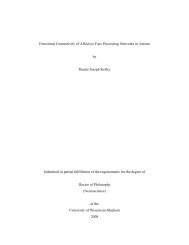
![[F-18]-L-DOPA PET scan shows loss of dopaminergic neurons](https://img.yumpu.com/41721684/1/190x146/f-18-l-dopa-pet-scan-shows-loss-of-dopaminergic-neurons.jpg?quality=85)
